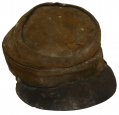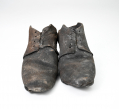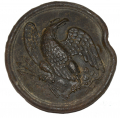site search
online catalog
Relics
Showing 131 to 135 out of 367
REGULAR ARMY MODEL 1872 KEPI FROM FORT PEMBINA, NORTH DAKOTA
This Model 1872 officer’s kepi comes from excavations at Fort Pembina, ND, conducted on private property with the owner’s permission. The fort was established in 1870 by troops of the 20th US… (1052-248). Learn More »
INDIAN WAR ARMY SHOES BY MUNDELL FROM FORT PEMBINA, ND
This pair of shoes is from the excavations at Fort Pembina, ND, and could be taken for attic or barn-finds, having been preserved by the wet, anaerobic soil conditions of the dig. They are solid, can… (1052-387). Learn More »
INDIAN WAR FIELD-USED CAMPAIGN HAT MADE FROM A CIVIL HARDEE HAT
This is a real field-used example of an Indian War US Army campaign hat made from a Civil War M1858 issue dress hat (the “Hardee” or “Jeff Davis” hat) that comes from the excavations at Fort… (1052-245). Learn More »
CIVIL WAR NCO SWORD CROSSBELT PLATE FROM FREDERICKSBURG
This pattern of belt plate was first adopted in 1826 with hooks on the reverse for the bayonet shoulder belt and made of stamped rolled brass for artillery and white metal for infantry. This was… (490-5799). Learn More »
NEW BERN, N.C., RECOVERED M1839 OVAL US BELT PLATE
This is the standard Union infantry enlisted man’s belt plate of the Civil War. Adopted in 1839, these plates are stamped, rolled brass with a lead solder filled back that anchors the fastening… (490-5808). Learn More »
Showing 131 to 135 out of 367
Most Popular
Historical Firearms Stolen From The National Civil War Museum In Harrisburg, Pa »
Theft From Gravesite Of Gen. John Reynolds »
Selection Of Unframed Prints By Don Troiani »
Fine Condition Brass Infantry Bugle Insignia »
British Imported, Confederate Used Bayonet »
Scarce New Model 1865 Sharps Still In Percussion Near Factory New »
featured item
ID’D COPY OF LLOYD’S MAP OF THE SOUTH – COLONEL JOHN TOWERS, 8th GA INFANTRY – WOUNDED AT GETTYSBURG
John Towers lived in Anderson, SC to 1849, then was a merchant in Cass County, GA. He moved to Rome in Floyd County, GA in 1855 and had a metal casting foundry there. He enrolled for war service and was commissioned Captain of Company E, 8th Georgia… (846-560). Learn More »
site search
Upcoming Events
May 16 - 18: N-SSA Spring Nationals, Fort Shenandoah, Winchester, VA Learn More »







